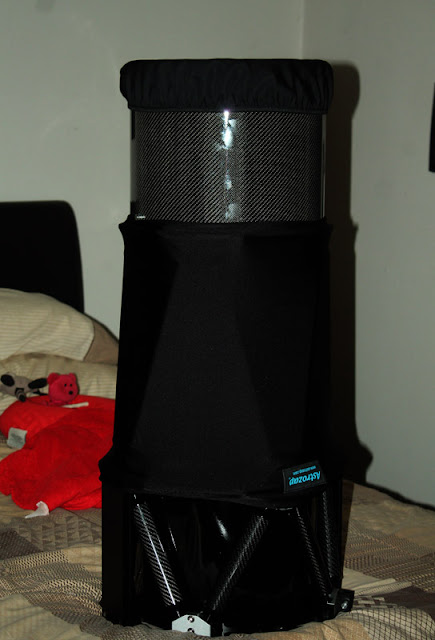Last month I linked to the Astro Tech truss RC, but those have yet to arrive at Astronomics. I found the same (GSO) scope in stock at High Point Scientific in New Jersey. This is the newest version (3) of the carbon truss scope. The primary cell in v1 was identical to the older solid tube RC scopes which had the focuser hanging off the cell. In v2 they decoupled the focuser attachment, and v3 added a focuser tip/tilt adjustment and a really nice 18 point cell. It also includes a little bracket and thumbscrew to mount a finder scope.
Here is a shot from Altair Astro showing the 18 point primary cell. This is a really nice upgrade from the original GSO RC telescopes.
The guys at High Point were very friendly and assured me that the scope they had in stock was indeed the newest version. A week later, UPS delivered a very big box. It didnt take me very long to open it to see what was inside.
I got her out of the box and made her more comfortable.
Since I almost always have to image in 100% humidity (yes, really) a dew shield and/or dew heater strip is mandatory. I really hate those floppy dew shields, so I splurged for this really nice bolt on carbon fiber dew shield from Teleskop Service in Germany. It actually arrived a day before the telescope, so I bolted it on to check the fit.
 |
| Those really arent my toys. They belong to my 5 year old, Lola. Thats her with her nose sticking out from under the red blanket. She didnt seem at all impressed with the new telescope. |
Here's a picture showing the back side of the scope. It comes with three fans to cool the primary mirror, and shows the new solid focuser attachment with tip/tilt adjustment screws, as well as the new finder scope bracket.
It took a little while to get the scope collimated. The primary mirror was off quite a bit. We did get it collimated though and the stars look very nice now. Here's a crop from one sub, magnified 300%.
It took a while to get the new flange to get my Moonlite CSL attached, but its all up and running now. Here's a picture of the scope with the stock focuser in its new home at Little Piney Observatory.....
.....and with the AstroZap shroud installed.
I also purchased the AstroZap dust cover from Astronomics. The scope comes with primary and secondary dust covers, but the primary cover isnt easy to get in and out of the truss structure. I worry about bumping the collimation out of adjustment, so just use the dust cover to try to keep things as clean as I can.
So far I've been very pleased with the scope. NGC 7635, the Bubble nebula, was official First Light for the scope, but the first completed imaged was a quick RGB of NGC 457, the E.T. Cluster. The full size image, as well as all the details and a description of the target can be seen here.
I'm still working to try to finish up the Bubble, but here's what I have so far.
Hopefully the weather will cooperate with me and I can finish this one, as well as a couple others I am working on. So far I have been using the TSFlat2 field flattener and shooting at f/8 and 2000mm focal length. As soon as I can get these finished, I'm wanting to test out the Astro Physics CCDT67 Telecompressor. I bought the scope mainly for globular clusters and small interesting galaxies, and NGC 7479 is one I have on my radar. Maybe I can give this one a try soon!! :-)










































